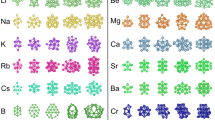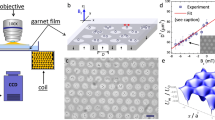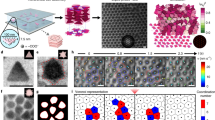Abstract
The controlled fabrication of very small structures at scales beyond the current limits of lithographic techniques is a technological goal of great practical and fundamental interest. Important progress has been made over the past few years in the preparation of ordered ensembles of metal and semiconductor nanocrystals1,2,3,4,5,6,7. For example, monodisperse fractions of thiol-stabilized gold nanoparticles8 have been crystallized into two- and three-dimensional superlattices5. Metal particles stabilized by quaternary ammonium salts can also self-assemble into superlattice structures9,10. Gold particle preparations with quite broad (polydisperse) size distributions also show some tendency to form ordered structures by a process involving spontaneous size segregation11,12. Here we report that alkanethiol-derivatized gold nanocrystals of different, well defined sizes organize themselves spontaneously into complex, ordered two-dimensional arrays that are structurally related to both colloidal crystals and alloys between metals of different atomic radii. We observe three types of organization: first, different-sized particles intimately mixed, forming an ordered bimodal array (Fig. 1); second, size-segregated regions, each containing hexagonal-close-packed monodisperse particles (Fig. 2); and third, a structure in which particles of several different sizes occupy random positions in a pseudo-hexagonal lattice (Fig. 3).

Shown are electron micrographs at low (a) and higher (b) magnification. c, The low-angle superlattice electron diffraction pattern obtained from this bimodal raft structure.

A ratio is ∼0.47. In this case, RA = 4.5 ± 0.7 nm and RB = 9.6 ± 1.5 nm.

Electron micrograph of a ‘random alloy’ of Au nanoparticles obtained for an RB/RA ratio greater than 0.85.
This is a preview of subscription content, access via your institution
Access options
Subscribe to this journal
Receive 51 print issues and online access
$199.00 per year
only $3.90 per issue
Buy this article
- Purchase on Springer Link
- Instant access to full article PDF
Prices may be subject to local taxes which are calculated during checkout

Similar content being viewed by others
References
Giersig, M. & Mulvaney, P. Preparation of ordered colloid monolayers by electrophoretic deposition. Langmuir 9, 3408–3413 (1993).
Mirkin, C. A., Letsinger, R. L., Mucic, R. C. & Storhoff, J. J. ADNA based method for rationally assembling nanoparticles into macroscopic materials. Nature 382, 607–609 (1996).
Brust, M., Bethell, D., Schiffrin, D. J. & Kiely, C. J. Novel gold-dithiol networks with non-metallic electronic properties. Adv. Mater. 7, 795–797 (1995).
Murray, C. B., Kagan, C. R. & Bawendi, M. G. Self-organisation of CdSe nanocrystallites into 3-dimensional quantum dot superlattices. Science 270, 1335–1338 (1995).
Whetten, R. L. et al. Nanocrystal gold molecules. Adv. Mater. 8, 428–433 (1996).
Motte, L., Billoudet, F., Lacaze, E., Douin, J. & Pileni, M. P. Self-organisation into 2D and 3D superlattices of nanosized particles differing by their size. J. Phys. Chem. B 101, 138–144 (1997).
Pileni, M. P. Nanosized particles made into colloidal assemblies. Langmuir 13, 3266–3276 (1997).
Brust, M., Walker, M., Bethell, D., Schiffrin, D. J. & Whyman, R. Synthesis of thiol-derivatised gold nanoparticles in a two phase liquid-liquid system. J. Chem. Soc. Commun. 801–802 (1994).
Reetz, M. T., Winter, M. & Tesche, B. Self assembly of tetra-alkylammonium salt-stabilised giant palladium clusters on surfaces. Chem. Commun. 147–148 (1997).
Fink, J., Kiely, C. J., Bethell, D. & Schiffrin, D. J. Self-organisation of nanosized Au particles. Chem. Mater. 10, 922–926 (1998).
Ohara, P. C., Leff, D. V., Heath, J. R. & Gelbart, W. M. Crystallisation of opals from polydisperse nanoparticles. Phys. Rev. Lett. 75, 3466–3469 (1995).
Murthy, S., Wang, Z. L. & Whetten, R. L. Thin films of thiol-derivatised gold nanocrystals. Phil. Mag. Lett. 75, 321–327 (1997).
Luedtke, W. D. & Landman, U. Structure, dynamics and thermodynamics of passivated Au nanocrystallites and their assemblies. J. Phys. Chem. 100, 13323–13329 (1996).
Terrill, R. H. et al. Monolayers in 3D NMR SAXS thermal and electron hopping studies of alkanethiol stabilised Au clusters. J. Am. Chem. Soc. 117, 12537–12548 (1995).
Badia, A. et al. Self-assembled monolayers on gold nanoparticles. Chem. Eur. J. 96, 359–36 (1996).
Wang, Z. L., Harfenist, S. A., Whetten, R. L., Bentley, J. & Evans, N. D. Bundling and interdigitation of adsorbed thiolate groups in self assembled nanocrystal lattices. J. Phys. Chem. 102, 3068–3072 (1998).
Wang, Z. L. Structural analysis of self-assembling nanocrystal superlattices. Adv. Mater. 10, 13–30 (1998).
Laves, F. The Theory of Alloy Phases 124–199 (Am. Society for Metals, Cleveland, Ohio, (1956)).
Sanders, J. V. & Murray, M. J. Ordered arrangements of spheres of two different sizes in opals. Nature 275, 201–202 (1978).
Sanders, J. V. & Murray, M. J. Close-packed structures of spheres of two different sizes I; Observations on natural opal. Phil. Mag. A 42, 705–720 (1980).
Yoshimura, S. & Haschisu, S. Order formation in binary mixtures of monodisperse lattices. Prog. Colloid Polym. Sci. 68, 59–70 (1983).
Haschisu, S. & Yoshimura, S. Optical demonstration of crystalline superstructures in binary mixtures of latex globules. Nature 283, 188–189 (1980).
Bartlett, P., Ottewill, R. H. & Pusey, P. N. Superlattice formation in binary-mixtures of hard sphere colloids. Phys. Rev. Lett. 68, 3801–3804 (1992).
Murray, M. J. & Sanders, J. V. Close-packed structures of spheres of two different sizes II; the packing densities of likely arrangements. Phil. Mag. A 42, 721–740 (1980).
Eldridge, M. D., Madden, P. A. & Frenkel, D. Entropy driven formation of a superlattice in a hard-sphere binary mixture. Nature 365, 35–37 (1993).
Hume-Rothery, W., Smallman, R. E. & Haworth, C. W. The Structure of Metals and Alloys (Metals and Metallurgy Trust, London, (1969)).
Cleveland, C. L., Landman, U., Shafigullin, M. N., Stephens, P. W. & Whetten, R. L. Structural evolution of larger gold clusters. Z. Phys. D 40, 503–508 (1997).
Hostetler, M. et al. Alkanethiolate gold cluster molecules with core diameters from 1.5 to 5.2nm; monolayer properties as a function of core size. Langmuir 14, 17–30 (1998).
Herring, C. Effect of change of scale on sintering phenomena. J. Appl. Phys. 21, 301–303 (1950).
Feldheim, L. & Keating, C. D. Self-assembly of single electron transistors and related devices. Chem. Soc. Rev. 27, 1–12 (1998).
Acknowledgements
We thank Carol Kiely for comments. This work was supported by the EPSRC.
Author information
Authors and Affiliations
Corresponding author
Rights and permissions
About this article
Cite this article
Kiely, C., Fink, J., Brust, M. et al. Spontaneous ordering of bimodal ensembles of nanoscopic gold clusters. Nature 396, 444–446 (1998). https://doi.org/10.1038/24808
Received:
Accepted:
Issue Date:
DOI: https://doi.org/10.1038/24808
This article is cited by
-
Crystallization of binary nanocrystal superlattices and the relevance of short-range attraction
Nature Synthesis (2023)
-
Numerical Approximation of the Two-Component PFC Models for Binary Colloidal Crystals: Efficient, Decoupled, and Second-Order Unconditionally Energy Stable Schemes
Journal of Scientific Computing (2021)
-
Primary growth of binary nanoparticle superlattices with distinct systems contingent on synergy: softness and crystalline anisotropy
Applied Nanoscience (2020)
-
Crystal engineering with DNA
Nature Reviews Materials (2019)
-
Synthesis and pH-dependent assembly of isotropic and anisotropic gold nanoparticles functionalized with hydroxyl-bearing amino acids
Applied Nanoscience (2018)
Comments
By submitting a comment you agree to abide by our Terms and Community Guidelines. If you find something abusive or that does not comply with our terms or guidelines please flag it as inappropriate.



